
White-chinned Petrel ashore; photograph by Peter Ryan
Anaïs Dasnon (Centre d'Etudes Biologiques de Chizé, Villiers en Bois, France) and colleagues have published open access in the Journal of Applied Ecology on the effects of bycatch mitigation measures on the demography of Vulnerable White-chinned Petrels Procellaria aequinoctialis breeding on Possession Island, Crozet Islands.
The paper’s abstract follows:
- “The impact of industrial fisheries on marine biodiversity is conspicuous in large pelagic vertebrate's fisheries bycatch. In seabirds, this led to the decline of many populations since the 1980s following the rise of global fishing effort. Bycatch mitigation measures were implemented since the 2000s, but their effects on the concerned seabird populations remain poorly quantified and understood.
- We studied the effects of bycatch mitigation measures on the demography of the white-chinned petrel, one of the most bycatch impacted seabirds whose populations suffered dramatic declines before the implementation of mitigation measures. To do so we (a) built multi-event capture–recapture models to estimate the demographic parameters of a population from Possession Island (southern Indian Ocean) over 30 years, (b) assessed the effect of climate and fishery covariates on demographic parameters, (c) built a population matrix model to estimate stochastic growth rate according to the management in fisheries bycatch and (d) estimated changes in breeding population density using distance sampling data.
- The population declined from the 1980s to the mid-2000s, while trawl and longline fisheries occurred with no bycatch mitigation measures. The negative effects of fishery bycatch through additive mortality and of rat predation on breeding success were likely the main drivers of this decline.
- Both modelled population growth rate and observed breeding densities showed an increase since the mid-2000s. We explained this trend by the improvement in survival probability BASDF probability with the local control of the rat population and changes in sea ice conditions on foraging grounds.
- Synthesis and applications. We provide a holistic approach to assess the effects of management measures by analysing datasets from sampling methods commonly employed in seabird studies. Our conclusions should encourage the eradication of invasive predatory species in seabird breeding areas and the strengthening of bycatch mitigation measures for the vulnerable seabird species, especially in international waters, but also the development of such measures considering the other marine large pelagic species threatened by fisheries bycatch (sharks, rays, turtles and marine mammals) since it could be crucial to avoid populations' extinction.”
With thanks to Anaïs Dasnon.
Reference:
Dasnon, A., Delord, K., Chaigne, A. & Barbraud, C. 2022. Fisheries bycatch mitigation measures as an efficient tool for the conservation of seabird populations. Journal of Applied Ecology doi.org/10.1111/1365-2664.14189.
John Cooper, ACAP Information Officer, 19 May 2022

 English
English  Français
Français  Español
Español